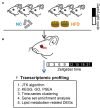High-fat intake reshapes the circadian transcriptome profile and metabolism in murine meibomian glands
- PMID: 37006922
- PMCID: PMC10062204
- DOI: 10.3389/fnut.2023.1146916
High-fat intake reshapes the circadian transcriptome profile and metabolism in murine meibomian glands
Abstract
Background: Nutritional and food components reshape the peripheral clock and metabolism. However, whether food challenges affect the circadian clock and metabolism of meibomian glands (MGs) has not been fully explored. This study was designed to analyze alterations in the rhythmic transcriptome and metabolism of MGs of murine fed a balanced diet or a high-fat diet (HFD).
Methods: Male C57BL/6J mice were maintained on a 12/12 h light/dark cycle and fed ad libitum on normal chow (NC) or HFD for 4 weeks. MGs were collected from sacrificed animals at 3-h intervals throughout a 24-h circadian cycle. The circadian transcriptome of MGs was analyzed via bioinformatics approaches using high-throughput RNA sequencing (RNA-seq). In addition, circadian oscillations of lipid components in MGs were analyzed.
Results: Meibomian glands displayed robust transcriptome rhythmicity. HFD feeding significantly altered the circadian transcriptome profile of MGs-including composition and phase-and spatiotemporally affected the enriched signaling pathways. In addition, HFD feeding significantly altered the normal rhythmic oscillations of lipid components in MGs.
Conclusion: Our data show that HFD significantly affects MGs' rhythmicity, which reveals a high sensitivity of MGs' clocks to lipid composition in food.
Keywords: RNA-seq; bioinformatics; circadian rhythm; high-fat diet; meibomian gland; metabolic dysfunction; transcriptome.
Copyright © 2023 Zou, Liu, Si, Huang, Qi, Pei, Lu, Huang and Li.
Conflict of interest statement
The authors declare that the research was conducted in the absence of any commercial or financial relationships that could be construed as a potential conflict of interest.
Figures







Similar articles
-
High-Fat Nutritional Challenge Reshapes Circadian Signatures in Murine Extraorbital Lacrimal Glands.Invest Ophthalmol Vis Sci. 2022 May 2;63(5):23. doi: 10.1167/iovs.63.5.23. Invest Ophthalmol Vis Sci. 2022. PMID: 35588356 Free PMC article.
-
Diurnal rhythm-modulated transcriptome analysis of meibomian gland in hyperlipidemic mice using RNA sequencing.Int Ophthalmol. 2025 Jan 31;45(1):57. doi: 10.1007/s10792-025-03431-7. Int Ophthalmol. 2025. PMID: 39890715
-
Time-Restricted Feeding Prevents Ablation of Diurnal Rhythms in Gastric Vagal Afferent Mechanosensitivity Observed in High-Fat Diet-Induced Obese Mice.J Neurosci. 2018 May 30;38(22):5088-5095. doi: 10.1523/JNEUROSCI.0052-18.2018. Epub 2018 May 14. J Neurosci. 2018. PMID: 29760179 Free PMC article.
-
Impact of nutrients on circadian rhythmicity.Am J Physiol Regul Integr Comp Physiol. 2015 Mar 1;308(5):R337-50. doi: 10.1152/ajpregu.00322.2014. Epub 2014 Dec 17. Am J Physiol Regul Integr Comp Physiol. 2015. PMID: 25519730 Free PMC article. Review.
-
Reciprocal Interactions between Circadian Clocks, Food Intake, and Energy Metabolism.Biology (Basel). 2023 Mar 31;12(4):539. doi: 10.3390/biology12040539. Biology (Basel). 2023. PMID: 37106739 Free PMC article. Review.
Cited by
-
Circadian disruption and ROS-NLRP3 signaling mediate sleep deprivation-enhanced silica nanoparticle toxicity in lacrimal glands.J Nanobiotechnology. 2025 Sep 2;23(1):600. doi: 10.1186/s12951-025-03630-5. J Nanobiotechnology. 2025. PMID: 40890823 Free PMC article.
-
Regulation of headache response and transcriptomic network by the trigeminal ganglion clock.Headache. 2024 Feb;64(2):195-210. doi: 10.1111/head.14670. Epub 2024 Jan 30. Headache. 2024. PMID: 38288634 Free PMC article.
-
Circadian clocks and their role in kidney and eye diseases across organ systems.Front Physiol. 2025 May 27;16:1583502. doi: 10.3389/fphys.2025.1583502. eCollection 2025. Front Physiol. 2025. PMID: 40496242 Free PMC article. Review.
-
Diabetes Reshapes the Circadian Transcriptome Profile in Murine Retina.Invest Ophthalmol Vis Sci. 2023 Oct 3;64(13):3. doi: 10.1167/iovs.64.13.3. Invest Ophthalmol Vis Sci. 2023. PMID: 37788001 Free PMC article.
References
LinkOut - more resources
Full Text Sources

